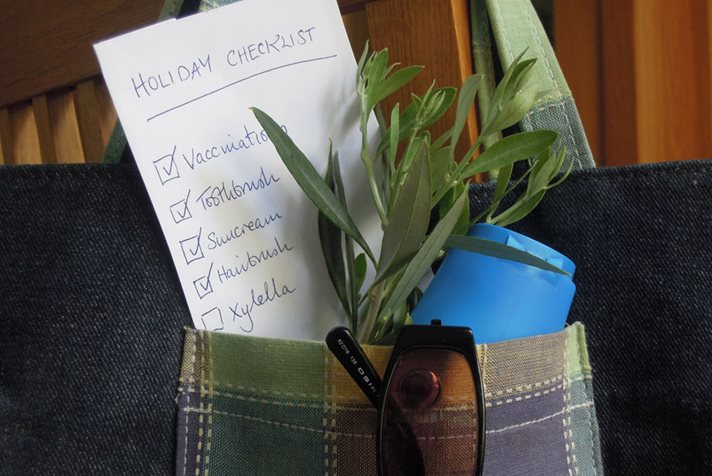Don't Add Xylella to Your Holiday Checklist

Pests and disease, although not much documented in the past, are something us gardeners have endured for as long as we have cultivated plants. In more recent years it seems we are now getting an influx in these problems arising. This is happening for several reasons. Partly we are importing in large volumes of plants and plant based products such as timber from varying locations across the globe. Our climate has seen temperatures rising, and with this the knock on effect on the plant and pests life cycle, allowing for some critters now successfully overwintering or for other pests from abroad surviving in our warming climate to expand their populations.
Thankfully for gardeners many of these vexations are limited to one plant family as a host, but this is not true of all of them. Hopefully by now you may have come across the name
Xylella. This to anyone working in the horticultural industry is the stuff of nightmares, but I feel it is a name not mentioned enough to the general public.
Originating in Central and Southern America and afflicting citrus, coffee and grapevines,
Xylella fastidiosa (a bacterium, that has many sub-species and strains) has already changed the face of France and Italy devastating the olive and vineyard plantations. With several outbreaks of different sub-species across Europe, and affecting a wide range of hosts (possibly as many as 350 species) among them oak, sycamore, cherry, olive, rosemary and lavender,
Xylella has already taken its toll and has been dubbed the ‘Ebola of the olive tree’.
The bacterium may be present in a plant initially without showing any symptoms. The vectors (already present in the UK) for carrying the bacterium from plant to plant are froghoppers and leafhoppers, who feed on the xylem fluid (the water transporting vessel) of the plant. Once infected symptoms can include leaf scorch, wilt, dieback and plant death. These symptoms are easily confused with other plant stresses such as frost damage, drought (and we have plenty of that at the moment), or other plant diseases.
The protocol set by EU legislation for dealing with an outbreak of
Xylella is that all host plants within a 100 metre area must be destroyed and the area treated to control the vectors. Restrictions will also be placed on businesses trading in host plants within a 5 kilometre area from the outbreak for 5 years.
So what can you as a gardener do to help keep this disease at bay? Well when shopping for plants you can help support the nationwide network of nursery men and women who propagate and grow their own stock in the UK. Opting for UK grown plants over imports from abroad means the likelihood is the plant will be more resilient to local climate, pests and diseases anyway. Nursery owners have a wealth of knowledge that you can tap into about growing plants, they can suggest the right plant for your growing conditions and you’d be supporting a much undervalued UK industry.
If you are travelling abroad this summer, then whatever you do, don’t bring back any kind of plant material, especially if heading to Europe. Some plants will be allowed in if accompanied by a phytosanitary certificate or plant passport. Plant passports may only be issued by businesses that are registered and authorised for the purpose of transporting plants. This proves your plants have been inspected, are free from dangerous pests and diseases, and are suitable to enter the UK. So if I were you I would enjoy that flora in its native setting, take photos, buy the fridge magnet and leave it there as you just don’t know what you will be bringing home. You wouldn’t want to be responsible for bringing a plant back that could re-shape our gardens and landscapes; our green and pleasant land for a very long time.